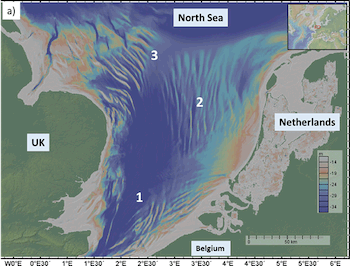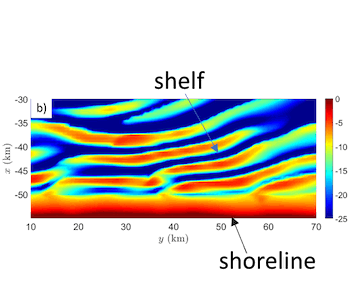A. Nnafie1*, H.E. Swart1, A. Falqués2, D. Calvete2
1 Institute for Marine and Atmospheric research Utrecht (Utrecht University),
2 Universitat Politècnica de Catalunya, Barcelona,
Introduction
Tidal sand ridges are large-scale bottom features that occur on sandy continental shelves with strong tidal currents, such as that of the southern North Sea (Figure 1a). These ridges have longshore spacings of several kilometres, heights of tens of meters, they evolve on centennial time scales and their crests are cyclonically rotated with respect to the direction of the dominant tidal currents. Tidal sand ridges are important for ecology by providing diverse habitats for fish and invertebrate communities (van Dijk et al., 2012; Atalah et al., 2013) and for coastal stability by dissipating wave energy during storms (Spencer et al., 2015). Many studies have focused on the formation and long-term evolution of these bottom features (see review by de Swart and Yuan, 2018), but little is known about their effects on the shoreline evolution. As these ridges affect the wave transformation and thus the alongshore sediment transport, it is expected that these ridges have a profound impact on the evolution of the shoreline. Conversely, changes in the shoreline will induce bathymetric changes that will affect the ridges. The objective of this study is to investigate the coupled dynamics of tidal sand ridges and shoreline undulations at decadal and centennial time scales.
Methods
Simulations are carried out by utilizing a continental shelf numerical model (Delft3D-SWAN; Nnafie et al., 2020, subm.), which is coupled to a shoreline evolution model (Q2D-morfo). The latter model is a nonlinear morphodynamic model for large-scale shoreline dynamics (Arriaga et al., 2017). The simulations, which start from an initially longshore uniform and cross-shore sloping bottom, are run for a period of 500 years.
Results
Model results show that undulations occur in the shoreline that have an alongshore scale similar to the alongshore scale of the tidal sand ridges (Figure 1b).


Figure 1 a) Bathymetric map of observed fields of tidal sand ridges (1, 2 and 3) in the North Sea. b) Simulated bed level after 500 years of morphodynamic evolution.
References
References available upon request.
I. Surname1*, F.N. Another-Surname2 , Y. Next-Surname2
1 University Name, Country; 2 Organization Name, Country
* Corresponding author: mail.name@organization.org


